wlewisiii
Just another hotel clerk
Chris, I hope you don't mind me posting this here, but as it came up in your thread, it seemed most appropriate here.
I've been shooting more film again and wanting to find a somewhat more economical approach to it. I can develop at home easily enough with daylight tanks and D-76 and Diafine but scanning has always been the bugbear in the room. Flatbeds have never been worth much for 35mm and good dedicated scanners are more than I can afford. In comes the Chinese made clone of the Nikon ES-2.
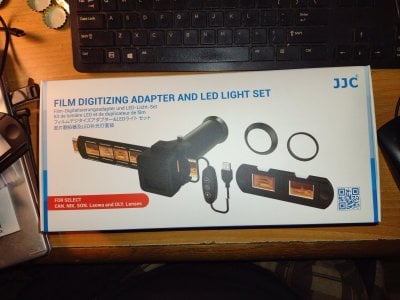
It has instructions for lots of AF lenses, naturally, but none for an old Micro-Nikkor 55/3.5 AI manual focus lens. Fortunately, the 55mm filter ring is what was expected by the kit and everything just screwed together fine. Once put together it looks like this:
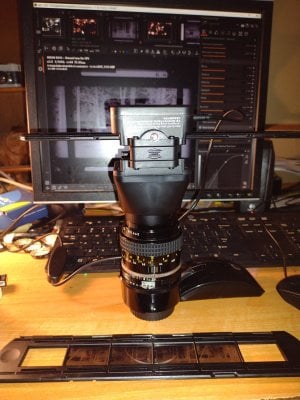
and attaches to the D810 like any other F mount lens. I have it in my non-cpu lens list, put the camera on A mode, turn on the LED light, and, with focus assist in the viewfinder it's not too hard to figure out quite quickly.
IF it's a decent negative (not a given with me, alas) and technique is correct (that comes along fairly quickly) the scans come out fast and good.
I use ART 1.20.2 for my RAW processing. In the editor's Special Effects Menu is a Film Negative item that allows me to flip the negative to positive and then post process as I desire. The scan samples presented here are with out any additional post processing. They are from a recent experimental roll of Kentmere 400 shot with my Nikon F4 and 28-105/3.5-4.5 af-d zoom:
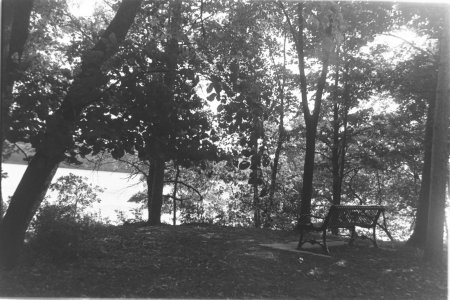
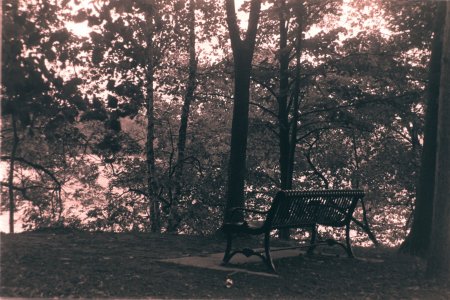
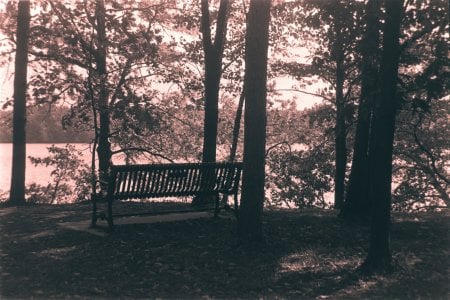
For the price, this is far and away the best scanning solution I've run into yet. It only arrived yesterday and this is only the first simple test. I have a roll or two to develop here at home that I'll test with later in the week for a more comprehensive experiment but overall, I have a positive feeling about this solution.
I've been shooting more film again and wanting to find a somewhat more economical approach to it. I can develop at home easily enough with daylight tanks and D-76 and Diafine but scanning has always been the bugbear in the room. Flatbeds have never been worth much for 35mm and good dedicated scanners are more than I can afford. In comes the Chinese made clone of the Nikon ES-2.

It has instructions for lots of AF lenses, naturally, but none for an old Micro-Nikkor 55/3.5 AI manual focus lens. Fortunately, the 55mm filter ring is what was expected by the kit and everything just screwed together fine. Once put together it looks like this:

and attaches to the D810 like any other F mount lens. I have it in my non-cpu lens list, put the camera on A mode, turn on the LED light, and, with focus assist in the viewfinder it's not too hard to figure out quite quickly.
IF it's a decent negative (not a given with me, alas) and technique is correct (that comes along fairly quickly) the scans come out fast and good.
I use ART 1.20.2 for my RAW processing. In the editor's Special Effects Menu is a Film Negative item that allows me to flip the negative to positive and then post process as I desire. The scan samples presented here are with out any additional post processing. They are from a recent experimental roll of Kentmere 400 shot with my Nikon F4 and 28-105/3.5-4.5 af-d zoom:



For the price, this is far and away the best scanning solution I've run into yet. It only arrived yesterday and this is only the first simple test. I have a roll or two to develop here at home that I'll test with later in the week for a more comprehensive experiment but overall, I have a positive feeling about this solution.
Tim Murphy
Well-known
Dear wlewisiii,Chris, I hope you don't mind me posting this here, but as it came up in your thread, it seemed most appropriate here.
I've been shooting more film again and wanting to find a somewhat more economical approach to it. I can develop at home easily enough with daylight tanks and D-76 and Diafine but scanning has always been the bugbear in the room. Flatbeds have never been worth much for 35mm and good dedicated scanners are more than I can afford. In comes the Chinese made clone of the Nikon ES-2.
View attachment 4829568
It has instructions for lots of AF lenses, naturally, but none for an old Micro-Nikkor 55/3.5 AI manual focus lens. Fortunately, the 55mm filter ring is what was expected by the kit and everything just screwed together fine. Once put together it looks like this:
View attachment 4829567
and attaches to the D810 like any other F mount lens. I have it in my non-cpu lens list, put the camera on A mode, turn on the LED light, and, with focus assist in the viewfinder it's not too hard to figure out quite quickly.
IF it's a decent negative (not a given with me, alas) and technique is correct (that comes along fairly quickly) the scans come out fast and good.
I use ART 1.20.2 for my RAW processing. In the editor's Special Effects Menu is a Film Negative item that allows me to flip the negative to positive and then post process as I desire. The scan samples presented here are with out any additional post processing. They are from a recent experimental roll of Kentmere 400 shot with my Nikon F4 and 28-105/3.5-4.5 af-d zoom:
View attachment 4829570View attachment 4829571View attachment 4829572
For the price, this is far and away the best scanning solution I've run into yet. It only arrived yesterday and this is only the first simple test. I have a roll or two to develop here at home that I'll test with later in the week for a more comprehensive experiment but overall, I have a positive feeling about this solution.
I bought the same JJC set-up during the summer. I've only developed and scanned one roll with it but I am pleased with how simple it is to use. I used a Nikon D700 and 60mm f2.8 AF-D macro lens. I've since replaced the D700 with a D750 but I am sure since both are full frame cameras that the process will be the same.
I shot a roll of Washi-S with a Pentax Spotmatic F I bought from Goodwill. I developed the film in an ARS-Lab Box I bought from a board member here and converted the scanned files in Lightroom Classic. I'm no artist so nothing so far has been particularly interesting but I am happy with what I was able to accomplish with the first roll of film I had developed in almost 45 years. I have another roll or two nearly complete so I will see if I can be as successful the next time around.
It just felt good to me actually control everything from the shot to the result from start to finish.
Regards,
Tim Murphy
Harrisburg PA
 More River 8-12-23_edited-express by Tim Murphy, on Flickr
More River 8-12-23_edited-express by Tim Murphy, on FlickrChriscrawfordphoto
Real Men Shoot Film.
Chris, I hope you don't mind me posting this here, but as it came up in your thread, it seemed most appropriate here.
I've been shooting more film again and wanting to find a somewhat more economical approach to it. I can develop at home easily enough with daylight tanks and D-76 and Diafine but scanning has always been the bugbear in the room. Flatbeds have never been worth much for 35mm and good dedicated scanners are more than I can afford. In comes the Chinese made clone of the Nikon ES-2.
For the price, this is far and away the best scanning solution I've run into yet. It only arrived yesterday and this is only the first simple test. I have a roll or two to develop here at home that I'll test with later in the week for a more comprehensive experiment but overall, I have a positive feeling about this solution.
William,
Thank you, I'm glad you posted this. I saw these on Amazon months ago and thought of buying one, but never did. I hadn't seen anyone else using them and didn't know if it would work well. I think it solves the problem I had when trying to scan film with my digital camera, which was keeping the film perfectly parallel to the sensor. I kept getting shots that were sharp on sharp on one side, but not the other. It wasn't a decentered lens; the sharp side was not the same in each shot as it would be in a bad lens, and I did get a few perfect 'scans.' I decided it was too much trouble and went back to using the scanner even though it is slow and a pain to use.
skopar steve
Well-known
I see it has holders for 120 film. Has anyone used it on 120 film? I have a minolta scanner for 35mm but nothing for 120.
wlewisiii
Just another hotel clerk
Slide holders. Don't know if they'd work for anything else.
Share:

